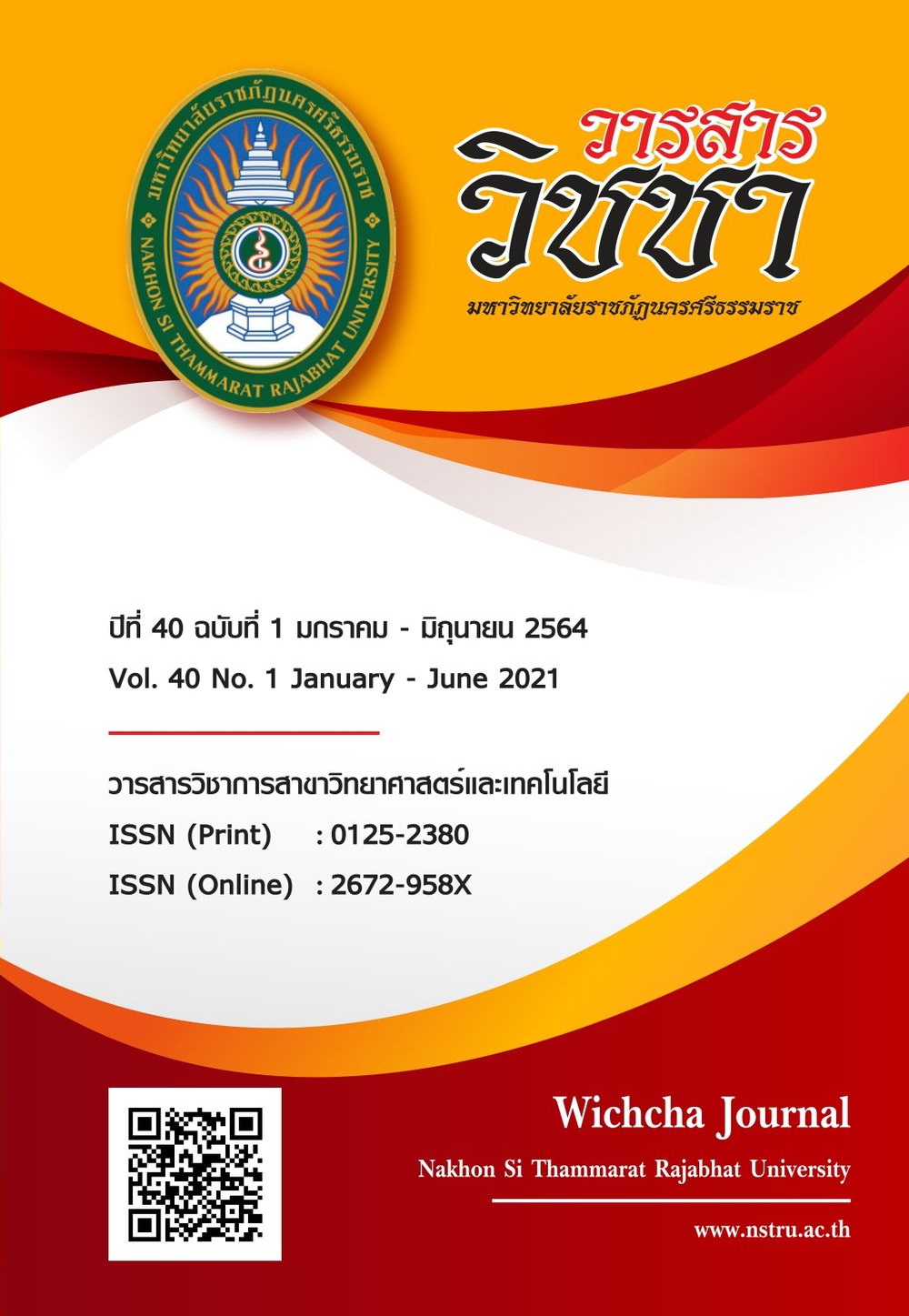The Efficiency of Catfish Processing Waste in the Formulated Diets on Cage Culture of Hybrid Catfish (Clarias macrocephalus x C. gariepinus) ประสิทธิภาพของเศษเหลือจากการแปรรูปปลาดุกในสูตรอาหารสำเร็จรูปต่อการเลี้ยงปลาดุกลูกผสม (Clarias macrocephalus x C. gariepinus) ในกระชัง
Main Article Content
Abstract
The use of fish processing wastes as alternative feedstuffs in fish diets is gaining importance because of increasing environmental benefits and reducing fish production costs. The present study was carried out to investigate the efficiency of hybrid catfish processing waste as protein and fat sources in the formulated diets on growth performance and economics of hybrid catfish (Clarias macrocephalus x C. gariepinus) cultured in a cage. The hybrid catfish with an average initial size of 4.4-4.5 cm. were stocked in 2 x 3 x 1 m cages at 500 fish per cage. They were fed by commercial diet (T1) comparing to a formulated diet containing 25.0% of catfish processing waste (T2) for 3 months. At the end of the experimental period, results showed that T2 fish exhibited a significantly higher (p < 0.05) growth rate than those of the T1 fish. The mean final weights (FW), % weight gain (%WG), and average daily gain (ADG) of T2 fish were 214.3±27.5 g, 4,598.9±663.4%, 2.3±0.3 g/day, respectively. On the other hand, FW, %WG, and ADG of T1 fish were 156.7±20.6 g, 3,468.9±547.9%, and 1.7±0.2 g/day, respectively. T2 fish also showed significantly better feed conversion ratio (1.1±0.1), higher survival rate (71.7±3.1%), lower feed cost (12.18 baht/1 kg of fish), and higher return on investment (171.7±12.5%) than T1 fish. Feed conversion ratio, survival rate, feed cost, and return on investment return of T1 fish were 1.4±0.1, only 56.4±8.2%, 34.77 baht/1 kg of fish, and 13.1±12.5%, respectively. This study demonstrated that hybrid catfish processing waste can be used as protein and fat sources in the formulated diets to improve growth performance and survival rate, to reduce feed conversion ratio and feed cost, and to increase the return on investment of hybrid catfish cultured in a cage.
Article Details
เนื้อหาและข้อมูลในบทความที่ลงตีพิมพ์ในวารสารวิชชา มหาวิทยาลัยราชภัฏนครศรีธรรมราช ถือเป็นข้อคิดเห็นและความรับผิดชอบของผู้เขียนบทความโดยตรง ซึ่งกองบรรณาธิการวารสารไม่จำเป็นต้องเห็นด้วยหรือร่วมรับผิดชอบใด ๆ
บทความ ข้อมูล เนื้อหา รูปภาพ ฯลฯ ที่ได้รับการตีพิมพ์ในวารสารวิชชา มหาวิทยาลัยราชภัฏนครศรีธรรมราช ถือเป็นลิขสิทธ์ของวารสารวิชชา มหาวิทยาลัยราชภัฏนครศรีธรรมราช หากบุคคลหรือหน่วยงานใดต้องการนำข้อมูลทั้งหมดหรือส่วนหนึ่งส่วนใดไปเผยแพร่ต่อหรือเพื่อการกระทำการใด ๆ จะต้องได้รับอนุญาตเป็นลายลักษณ์อักษรจากวารสารวิชชา มหาวิทยาลัยราชภัฏนครศรีธรรมราชก่อนเท่านั้น
The content and information in the article published in Wichcha journal Nakhon Si Thammarat Rajabhat University, It is the opinion and responsibility of the author of the article. The editorial journals do not need to agree. Or share any responsibility.
References
กลุ่มวิจัยและวิเคราะห์สถิติการประมง. (2562). สถิติการประมงแห่งประเทศไทย พ.ศ. 2560. กรุงเทพฯ: กองนโยบายและยุทธศาสตร์พัฒนาการประมง.
ธนากร เหมะสถล ดวงใจ พิสุทธิ์ธาราชัย และวรพงษ์ นลินานนท์. (2561). ผลของนมหมักกรดในสูตรอาหารเลี้ยงปลาดุกบิ๊กอุยในกระชัง. วารสารวิทยาศาสตร์และเทคโนโลยี มหาวิทยาลัยอุบลราชธานี, 20(1), 28-35.
ธนาภรณ์ จิตตปาลพงศ์. (2557). การสร้างสูตรอาหารสัตว์น้ำและสูตรอาหารสัตว์น้ำเศรษฐกิจ. กรุงเทพฯ: ราชการบริหารส่วนกลาง.
ธีระวัฒน์ รัตนพจน์ เกรียงศักดิ์ เม่งอำพัน สุดาพร ตงศิริ และดวงพร อมรเลิศพิศาล. (2561). องค์ประกอบกรดไขมันของน้ำมันปลาน้ำจืดและผลของประสิทธิภาพต่อการเจริญเติบโตในปลานิล. วารสารวิจัยและส่งเสริมวิชาการเกษตร, 35(2)(พิเศษ), 11-20.
พิเชต พลายเพชร. (2557). งานวิจัยด้านอาหารสำหรับการเลี้ยงปลาดุกอุยเทศ. วารสารวิทยาศาสตร์ และเทคโนโลยี, 3(2), 52-70.
รุ่งกานต์ กล้าหาญ บัณฑิต ยวงสร้อย และจิตตรา วีระกุล. (2557). การเจริญเติบโต ประสิทธิภาพการใช้อาหาร และคุณภาพเนื้อของปลาดุกลูกผสมที่ได้รับอาหารผสมฟักทอง. แก่นเกษตร, 42(1)(พิเศษ), 785-791.
วีรภัทร ผ่องศรี นิวุฒิ หวังชัย ดวงพร อมรเลิศพิศาล และสุดาพร ตงศิริ. (2558). ประสิทธิภาพการเจริญเติบโตของปลาดุกลูกผสม (Clarias macrocephalus x Clarias gariepinus) ที่เลี้ยงด้วยอาหารผสมไส้ไก่. วารสารวิจัยเทคโนโลยีการประมง, 9(2), 12-22.
สราวุธ เย็นเอง และสุธี เกื้อเกตุ. (2561). การศึกษาอัตราการเจริญเติบโตและอัตราการแลกเนื้อของปลาดุกลูกผสมที่เลี้ยงโดยให้อาหารสำเร็จรูปร่วมกับการเสริมอาหารช่วงกลางคืนด้วยแมลงบินจากกับดักเครื่องดูดแมลงอัตโนมัติ. วารสารวิชาการสถาบันการอาชีวศึกษาเกษตร, 2(2), 19-29.
สายใจ วิบูลย์พันธ์. (2556). การพัฒนากระบวนการผลิตปลาดุกร้าเชิงพาณิชย์. วิทยานิพนธ์วิทยาศาสตรมหาบัณฑิต. มหาวิทยาลัยทักษิณ, พัทลุง.
อัสวิน ภักฆวรรณ. (1 พฤศจิกายน 2560). “ปลาดุกร้า” พัทลุงแต่งตัวขึ้น GI สะพัดกว่า 230 ล้านบาท. เทคโนโลยีชาวบ้าน, 30, หน้า 102.
Abarra, S.T., Velasquez, S.F., Velasquez, K.D.D.C, Felipe, J.L.F., Tayamen, M.M. and Ragaza, J. A. (2017). Replacement of fishmeal with processed meal from knife fish Chitala ornata in diets of juvenile Nile tilapia Oreochromis niloticus. Aquaculture Reports, 5, 76-83.
Al-Souti, A., Al-Sabahi, J., Soussi, B. and Goddard, S. (2012). The effects of fishoil-enriched diets on growth, feed conversion and fatty acid content of red hybrid tilapia, Oreochromis sp. Food Chemistry, 133(3), 723-727.
AOAC. (2000). Official methods of analysis. (17th ed). Gaithersburg: The Association of Official Analytical Chemists.
APHA. (1995). Standard methods for the examination of water and waste water. (10th ed). Washington: American Public Health Association.
Effiong, B.N. and Fakunle, J.O. (2013). Fatty acid composition of catfish (Clarias gariepinus) viscera oil. Journal of Fisheries and Aquatic Science, 8(1), 299-301.
Hien, T.T.T., Tuan, L., Tu, T.L.C. and Tam, B.M. (2018). Dietary protein requirement of bighead catfish (Clarias macrocephalus Gunther, 1864) fingerling. International Journal of Scientific and Research Publications, 8(11), 200-205.
Hodar, A.R., Vasava, R.J., Mahavadiya, D.R. and Joshi, N.H. (2020). Fish meal and fish oil replacement for aqua feed formulation by using alternative sources: a review. Journal of Experimental Zoology, India, 23(1), 13-21.
Likitrattanaporn, C. (2016). Development of fishmeal production from catfish processing waste. International Journal of GEOMATE, 11(6), 2874-2878.
Mohanta, K.N., Subramanian, S. and Korikanthimath, V.S. (2013). Evaluation of different animal protein sources in formulating the diets for blue gourami, Trichogaster trichopterus fingerlings. Journal of Aquaculture Research and Development, 4(2), 1-7.
Musyoka, S.N., Liti, D., Ogello, E.O., Meulenbroek, P. and Waidbacher, H. (2020). Earthworm, Eisenia fetida, bedding meal as potential cheap fishmeal replacement ingredient for semi-intensive farming of Nile Tilapia, Oreochromis niloticus. Aquaculture Research, 51(6), 2359-2368.
Sivaramakrishnan, T., Sahu, N.P., Jain, K.K., Muralidhar, A.P., Saravanan, K., Ferosekhan, S., Praveenraj, J. and Artheeswaran, N. (2017). Optimum dietary lipid requirement of Pangasianodon hypophthalmus juveniles in relation to growth, fatty acid profile, body indices and digestive enzyme activity. Aquaculture International, 25(2), 941-954.
Sotolu, A.O. (2009). Comparative utilizations of fish waste meal with imported fishmeal by African catfish (Clarias gariepinus). American-Eurasian Journal of Scientific Research, 4(4), 285-289.
Vargas, R.J., Dotta, G., Mouriño, J.L., da Silva, B.C. and Fracalossi, D.M. (2013). Dietary lipid sources affect freshwater catfish jundiá, Rhamdia quelen, survival, when challenged with Aeromonas hydrophila. Acta Scientiarum Animal Sciences, 35(4), 349-355.
Zuo, R., Ai, Q., Mai, K., Xu, W., Wang, J., Xu, H., Liufu, Z. and Zhang, Y. (2012). Effects of dietary docosahexaenoic to ecosapentaenoic acid ratio (DHA/EPA) on growth, nonspecific immunity, expression of some immune related genes and disease resistance of large yellow croaker (Larmichthys crocea) following natural infestation of parasites (Cryptocaryon irritans). Aquaculture, 334-337, 101-110.


